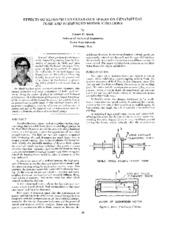| dc.description.abstract | Annular clearance spaces, such as impeller wearing rings, inter0stage bushes and balance drums in centrifugal pumps, or the fluid-filled clearance around the armature of the submerged motor, at a first glance present the appearance of very weak journal bearings. The fluid has very low viscosity compared with lubricating oils, and clearances are much larger than in proper journal bearings. Two factors invalidate this deceptive view. Firstly, the Reynold numbers of flows in these spaces are very high, rendering flows turbulent. This greatly increases effective viscosities. Secondly, fluid inertia effects not normally encountered in journal bearings and become basic determining factors of the bearing forces raised by internal clearances of the type indicated. In clearance spaces of centrifugal pumps, the high pressure differences across the clearance spaces bring about a sudden pressure drop owing to acceleration into the space. This converts the clearance space into a powerful hydrostatic bearing. As the journal rotates and vibrates, damping and crossing coupling forces are developed as well as radial stiffness. Here, fluid inertia is significant only in the entry loss effect which controls hydrostatic stiffness. In the submerged motor, where the fine clearance surrounds a large length of shaft, fluid inertia effects in the clearance space itself become dominant. Both types of clearance space alter the synchronous response and stability limits of the rotor (beyond recognition), as compared with the performance in air. In centrifugal pumps, generally, the internal clearances both raise and damp critical speeds and improve stability margins. There are, however, special circumstances where these clearances become destabilizing elements. In submerged motors, critical speeds are substantially reduced and damped, and the type of destabilization normally associated with circular journal bearings may be encountered. The paper explains these phenomena and illustrates them with simple calculations. | en |


